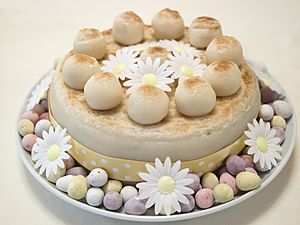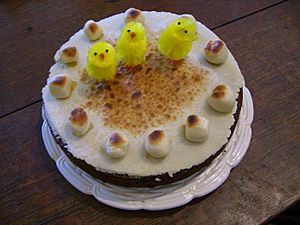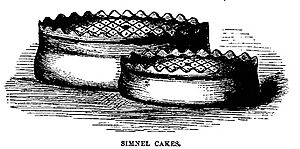Simnel cake facts for kids

Simnel cake
|
|
| Type | Fruitcake |
|---|---|
| Course | Dessert |
| Place of origin | United Kingdom |
A Simnel cake is a special kind of fruitcake that people enjoy in the United Kingdom, Ireland, and other places where people from these countries have moved. It's often eaten during Lent and Easter.
What makes a Simnel cake special? It has yummy layers of almond paste or marzipan (a sweet paste made from almonds). You'll usually find one layer in the middle of the cake and another on top. The top is also decorated with eleven small balls made from the same almond paste.
This cake was first made for the fourth Sunday in Lent. This day has many names, like Refreshment Sunday, Mothering Sunday, or Simnel Sunday, named after the cake itself! In the UK today, it's mostly known as a delicious treat for Easter Sunday.
Contents
What is a Simnel Cake?
Simnel cake is a light and tasty fruitcake. It's made with common baking ingredients. These include white flour, sugar, butter, eggs, and nice-smelling spices. It also has lots of dried fruits, zest from citrus fruits, and candied peel.
Sometimes, bakers add orange flower water or brandy to the cake mix. This gives it extra flavor. The almond paste or marzipan is a key part of the cake. A layer is placed inside before baking. More is used to decorate the top after it's cooked.
Most recipes suggest baking the cake for at least 90 minutes. To stop the marzipan from burning, bakers often line the cake tin with several layers of baking paper. Sometimes, brown paper is wrapped around the outside of the tin too.
How is Simnel Cake Decorated?
The most common way to decorate a Simnel cake is with eleven marzipan balls. These balls are said to represent the twelve apostles (Jesus's main followers), but without Judas Iscariot, who betrayed Jesus. Sometimes, twelve balls are used instead, to represent Jesus and the eleven loyal apostles.
However, some older cookbooks, like May Byron's Pot-Luck Cookery, mention decorating with marzipan balls without explaining this story. Her ideas might have come from even older ways of decorating, which sometimes involved making a fancy, wavy edge on the cake.
The History of Simnel Cake
Simnel cakes have been around for a very long time, at least since medieval times. Back then, rules about bread suggest these cakes were first boiled and then baked. This led to a funny story about how the cake was invented.
This story was popular from the 1700s to the 1930s. It tells of a made-up couple, Simon and Nelly, who argued about making a Simnel cake. Simon wanted to boil it, and Nelly wanted to bake it. After hitting each other with kitchen tools, they decided to do both! That's how the cake got its name, or so the story goes.
Simnel Cake and Mothering Sunday
Simnel cakes are often linked to Mothering Sunday. This day is also sometimes called Simnel Sunday. A historian named Ronald Hutton explains that in the 1600s, in parts of England, young apprentices and servants who lived away from home would visit their mothers on Mothering Sunday. They would check on their families and bring food or money if needed.
This time of year was often when food supplies were low. The Simnel cake, being full of calories, was a good and helpful gift. Over time, the cake simply became a special treat for Easter.
What Does "Simnel" Mean?
The meaning of the word "simnel" isn't perfectly clear. In 1226, there was a mention of "bread made into a simnel." This was understood to mean the finest white bread. The word might come from the Latin word simila, which means "fine flour." This is also where the word "semolina" comes from.
Another idea comes from John de Garlande. He thought the word was like "placenta cake," which was a cake meant to be pleasing.
Different Kinds of Simnel Cakes
Different towns used to have their own special recipes and shapes for Simnel cakes. Places like Bury and Shrewsbury made many cakes using their unique recipes.
The Chambers Book of Days from 1869 shows a picture of the Shrewsbury Simnel cake. It says that in Shropshire and Herefordshire, especially in Shrewsbury, people made rich and expensive cakes called Simnel Cakes during Lent, Easter, and Christmas.
These cakes were "raised cakes." Their crust was made from fine flour and water, with enough saffron to give it a deep yellow color. The inside was filled with rich fruitcake ingredients, like lots of candied lemon peel. The cakes were made very stiff, tied in a cloth, and boiled for several hours. After that, they were brushed with egg and baked. When they were ready to sell, the crust was as hard as wood!
Today, in Shrewsbury and other parts of England, the Simnel cake is usually made using the Bury recipe, which is the more common style we see now.



